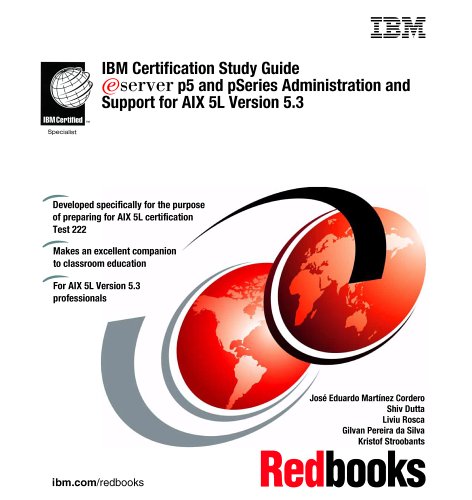

Most ebook files are in PDF format, so you can easily read them using various software such as Foxit Reader or directly on the Google Chrome browser.
Some ebook files are released by publishers in other formats such as .awz, .mobi, .epub, .fb2, etc. You may need to install specific software to read these formats on mobile/PC, such as Calibre.
Please read the tutorial at this link: https://ebookbell.com/faq
We offer FREE conversion to the popular formats you request; however, this may take some time. Therefore, right after payment, please email us, and we will try to provide the service as quickly as possible.
For some exceptional file formats or broken links (if any), please refrain from opening any disputes. Instead, email us first, and we will try to assist within a maximum of 6 hours.
EbookBell Team

4.8
44 reviews
ISBN 10: 0738496499
ISBN 13: 9780738496498
Author: IBM Redbooks
Introduction: Preparing for Your IBM Certification
1.1 About the IBM Certified Specialist Exam
1.2 Who Should Use This Study Guide
1.3 How to Use This Book: A Guided Study Plan
1.4 Hardware and Software Requirements for Practical Labs
1.5 Navigating the AIX 5L Documentation
Part I: IBM pSeries and AIX 5L Fundamentals
Chapter 1: IBM POWER5 and pSeries Architecture
2.1 Overview of the POWER5 Processor
2.2 pSeries Server Models and Components
2.3 Introduction to Logical Partitioning (LPAR)
2.4 Shared Processor Pools and Micro-Partitioning
2.5 Virtual I/O (VIO) and Virtual Networking
Chapter 2: AIX 5L Version 5.3 Core Concepts
3.1 The AIX Operating System Structure
3.2 Understanding the Object Data Manager (ODM)
3.3 The Role of the Kernel and Kernel Extensions
3.4 Navigating the System Management Interface Tool (SMIT)
3.5 Essential AIX Commands and Shells
Part II: System Installation and Configuration
Chapter 3: Installation and Migration
4.1 Planning the AIX Installation
4.2 Methods of Installation: CD/DVD, NIM, and Mksysb
4.3 Performing a Base Operating System (BOS) Installation
4.4 Upgrading and Migrating AIX Versions
4.5 Post-Installation Configuration and Best Practices
Chapter 4: The AIX Boot Process
5.1 Understanding the Boot Phases (IPL)
5.2 The Boot Logical Volume and Boot Image
5.3 How to Boot into Maintenance Mode
5.4 Troubleshooting Common Boot Issues
Part III: Hardware Management and LPAR Administration
Chapter 5: Hardware Management Console (HMC) Administration
6.1 Connecting and Configuring the HMC
6.2 Managing Partitions from the HMC
6.3 Using the HMC to Manage Virtual Resources
6.4 Backing Up and Restoring HMC Data
Chapter 6: Dynamic LPAR and Virtualization Management
7.1 Adding and Removing Resources Dynamically
7.2 Understanding LPAR Profiles and DLPAR Operations
7.3 Configuring and Managing the Virtual I/O Server (VIO)
7.4 Mapping Virtual Devices to Physical Resources
Part IV: System and User Administration
Chapter 7: User and Security Management
8.1 Creating and Managing User and Group Accounts
8.2 Understanding File Permissions and Ownership
8.3 User Authentication and Password Policies
8.4 Introduction to Role-Based Access Control (RBAC)
Chapter 8: System and Software Management
9.1 Managing System Startup and Shutdown
9.2 Understanding Run Levels and the inittab File
9.3 Using installp and smitty for Software Management
9.4 Applying Maintenance Levels, Fix Packs, and APARs
Part V: Storage Management
Chapter 9: The Logical Volume Manager (LVM)
10.1 Key LVM Concepts: Physical Volumes (PVs), Volume Groups (VGs), Logical Volumes (LVs)
10.2 Creating and Managing Volume Groups
10.3 Creating and Extending Logical Volumes
10.4 Mirroring and Striping Logical Volumes
10.5 Managing Physical Disks and MPIO
Chapter 10: Filesystem Administration
11.1 Journaled File System (JFS2) Features
11.2 Creating, Mounting, and Unmounting Filesystems
11.3 Managing Filesystem Space and Quotas
11.4 Troubleshooting Filesystem Integrity Issues
Part VI: Network and Performance Management
Chapter 11: TCP/IP Network Configuration
12.1 Configuring Network Interfaces and Adapters
12.2 IP Addressing, Subnetting, and Routing
12.3 Name Resolution (DNS and /etc/hosts)
12.4 Network Service Management (inetd, xinetd)
Chapter 12: Performance Monitoring and Tuning
13.1 Using Key Performance Tools (topas, vmstat, iostat, netstat)
13.2 Analyzing CPU, Memory, Disk I/O, and Network Bottlenecks
13.3 Tuning Kernel Parameters
13.4 LVM and Filesystem Tuning for Performance
Part VII: Backup and Disaster Recovery
Chapter 13: System Backup Strategies
14.1 The mksysb Command: Creating a System Image Backup
14.2 Backing Up Volume Groups with savevg
14.3 Using tar and cpio for File-Level Backups
14.4 Planning a Backup Schedule
Chapter 14: System Recovery
15.1 Restoring a System from a mksysb Image
15.2 Recovering Corrupted Volume Groups
15.3 Restoring Individual Files and Directories
15.4 Disaster Recovery Planning
Part VIII: Troubleshooting and Problem Determination
Chapter 15: Problem Determination and Error Handling
16.1 Using the Error Log (errpt)
16.2 Analyzing System Dumps and Tracing
16.3 Common Troubleshooting Scenarios (Boot failures, LVM errors)
16.4 Using Diagnostic Tools and Service Aids
ibm certification study guide p5
ibm cybersecurity analyst professional certificate practice exam
ibm certification program
ibm cybersecurity analyst professional certificate assessment exam answers pdf
ibm cybersecurity analyst professional certificate assessment
Tags: IBM Redbooks, Certification, Pseries